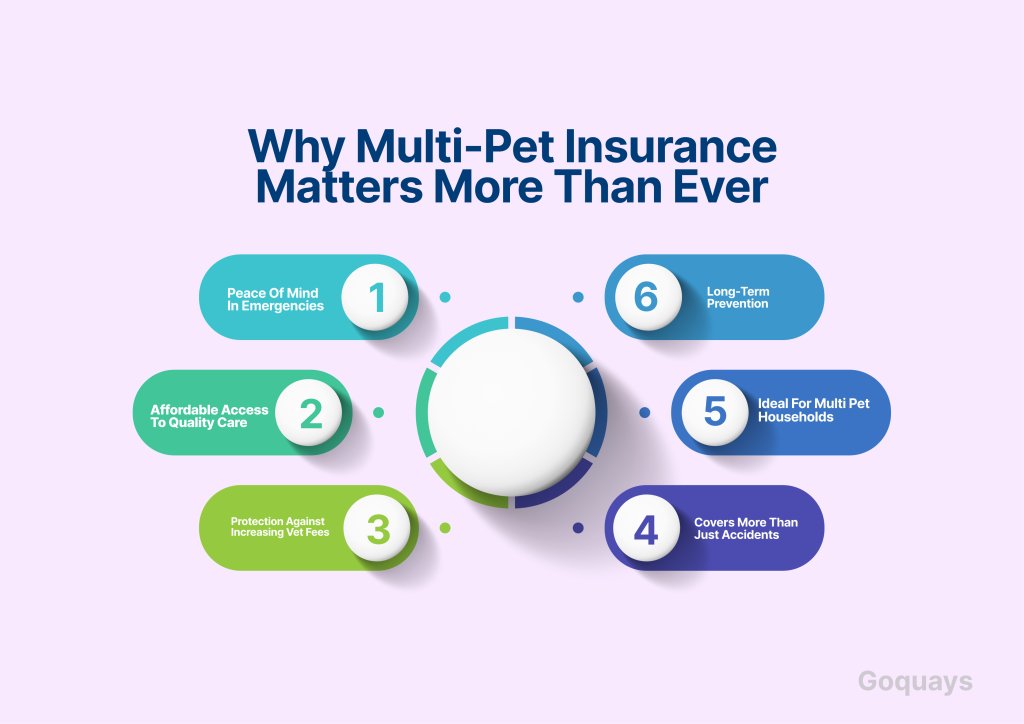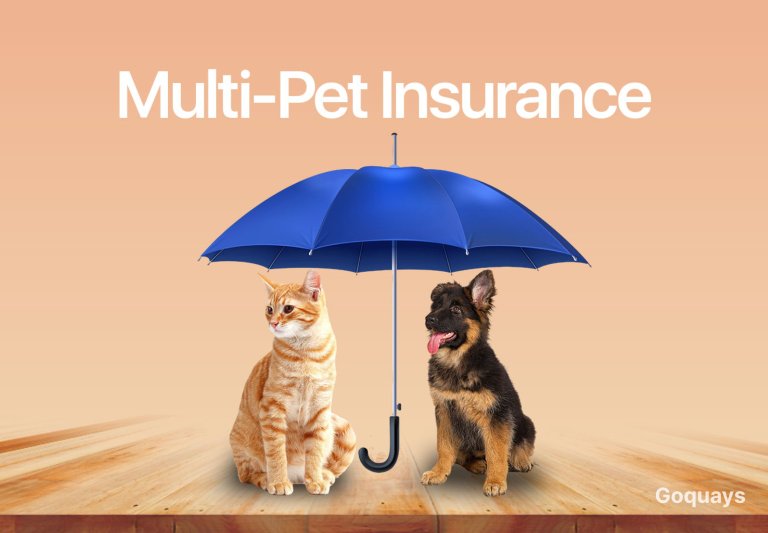Owning multiple pets is a joyful and fulfilling experience, but it also means double (or triple!) the vet visits, grooming, and medical care. This is where multi-pet insurance comes in. If you’re juggling vet bills and worried about the cost of keeping all your furry friends protected, we’re here to help you compare different multi pet insurance providers to determine which provider is most suitable for you.
Multi pet insurance is a smart and cost-effective solution designed to protect all your pets under one easy to manage policy. With several providers offering different levels of coverage, features, and discounts, choosing the right multi pet insurance can be daunting. Not to worry, we have broken it down for you.
This guide breaks down why pet insurance is essential, the types of cover available, what’s included, how policies work, and how to compare multi-pet insurance providers, including the tailored plans we offer you at Quays pet insurance, so you can make an informed choice for your whole animal family.
Why Multi-Pet Insurance Matters More Than Ever

Pet ownership offers companionship, unconditional love, and great delight, but it also comes with significant responsibilities. The price of veterinary treatment can easily reach thousands of pounds, covering anything from urgent surgery to terminal ailments. This makes pet insurance not just important but essential. Here are some of the reasons why pet insurance has become more crucial than ever:
Peace of Mind in Emergencies
Unexpected illnesses and accidents can occur at any time. Treatment for accidental falls, fractures, poisoning, or an allergic response can be expensive especially when you did not plan for it. Instead of having to make painful decisions based only on cost, pet insurance gives you financial peace of mind and guarantees that you’re ready for anything.
Affordable Access to Quality Care
Having the ideal pet insurance gives you access to the best veterinary care, diagnostic tests, and consultation with specialists in the event that your pet is suffering from a serious or unusual ailment. With pet insurance, you do not have to worry about the financial strain of affordable healthcare for your pets.
Protection Against Increasing Vet Fees
Vet fees are continuously increasing in this country, especially if you live in a place like London. According to industry data, vet fees for the treatment of dogs range from £500 to £1500 depending on the illness. Insurance can help pay up to 80% of these costs. Insurance can also help you manage long term conditions such as diabetes and arthritis.
Covers More Than Just Accidents
Pet insurance can cover a wide range of injuries and illnesses, depending on the policy. Disease, genetic disorders, dental care, prescription drugs, operations, and even behavioural or physical therapy is covered by some insurance policies. Routine wellness exams, vaccinations, and flea treatments are also included in some comprehensive plans.
Ideal for Multi Pet Households
Expectedly, your financial risk exposure increases if you own more than one pet. With bundle discounts, fewer administrative hurdles, and an affordable solution to guarantee no pet is left uninsured, multi-pet insurance policies let you cover all of your pets under a single policy.
Long-Term Prevention
Some pet insurance companies encourage frequent veterinary visits by covering preventive care or routine examinations. This translates to better long-term health for your pets through early diagnosis, and proactive treatment.
Types of Pet Insurance
Selecting the appropriate kind of pet insurance can significantly impact the protection of your furry family members. There is no one-size-fits-all approach to pet insurance; plans differ in terms of duration, cost, and coverage. You can select an insurance that meets both your financial circumstances and your pet’s medical requirements by being aware of the various types that are available. The main types of pet insurance are:
Lifetime Pet Insurance
As the name implies, lifetime pet insurance protects your pet for the duration of their life. It provides the most comprehensive type of coverage and your pet will be covered for illnesses and injuries throughout their lifetime as long as you continue to renew the policy.
Pre-existing conditions are usually not covered, unless for an additional fee depending on the provider, but any new illnesses or injuries are covered
Additionally, some insurers still place a cap on the annual amount you can claim for each ailment, even if you have a lifetime insurance plan. This type of insurance costs more than the other types and premiums can increase over time.
Maximum Benefit
This type of pet insurance, also known as per condition cover, allows you to file a claim for each disease or injury your pet sustains up to a pre-determined amount. Even if the policy is still in effect, any further treatment for that ailment is no longer covered after you’ve reached that cap. It is ideal for pet owners seeking reasonably priced continuing care and those with medium-term illnesses.
With maximum benefit cover, there are no restrictions, you can continue to make claims for the same illness or injury until you reach the predetermined amount, unlike other insurance types with a time restriction.
Time-Limited Cover
Time-limited pet insurance as the name implies offers you cover for a specified period of time, usually 12months after the diagnosis of illness or injury date. Even if the treatment cap hasn’t been used completely, the condition is then excluded.
However, even if you renew the policy, you will not be eligible to make another claim for that particular illness or injury. It is ideal for those seeking temporary coverage for minor illnesses and injuries.
Accident-Only Cover
Accident-only coverage, typically one of the most affordable pet insurance options, safeguards your pet in the event that they are injured in an accident and require medical attention.
This type of policy covers the costs of treating injuries sustained in an accident; it typically excludes coverage for illnesses or medical conditions. Of course, that is, unless you can show that an accident caused the condition.
Even so, a lot of insurance companies do not cover it. This type of insurance is ideal for pet owners with young healthy pets.
What Does Pet Insurance Cover?
Selecting the right coverage for your pet requires that you have a good understanding of what each policy covers and what it doesn’t. Most pet insurance policies offer a basic set of benefits intended to promote both your peace of mind and your pet’s health. These include:
- Vet fees for treatment of illnesses and injuries
- Diagnostic tests such as x-rays, scans, and blood tests
- Surgery and hospitalization including minor and major surgeries
- Prescription medication and alternative therapies
- Third-party liability (for Dogs) if they injure someone or damage property
- Finding a lost or stolen pet.
- Boarding fees for when you’re sick or need to travel.
What Pet Insurance Doesn’t Cover
- Vaccinations
- Pre-existing conditions
- Dental treatments
- Spaying and Neutering
- Microchipping
- Elective or cosmetic procedures
How Does Pet Insurance Work?
Pet insurance is designed to give financial protection when your pet becomes ill or injured, just like health insurance for humans, it helps cover the cost of unforeseen medical bills, giving pet owners peace of mind and ensuring they receive the treatment they need without delay.
Here is a detailed explanation of how pet insurance works, including with important terminology and procedures you should be aware of:
Choose the Right Policy
Choose an insurance plan that provides the right cover for your pet while considering your budget and the needs of your pet. Consider the limits and exclusions of your plan, the amount of premium you pay annually or monthly.
At Quays, we offer multi pet insurance policies that are tailored to meet the needs of your pet, ensuring that each pet is appropriately protected under one convenient plan.
Choose How you Want to Pay
After deciding on a plan, you will start making monthly or yearly premium payments. The price is determined by the breed and age of your pet, where you live, the extent of coverage you desire and finally if you’re insuring a single pet or multiple pets.
With Quays’ multi-pet discount, covering more than one furry friend under the same provider often results in lower individual premiums.
Visit the Vet When You Need to
If your pet becomes ill or injured, take them to the vet for proper evaluation and treatment. Ensure that you keep a record of the diagnosis and treatment, all payment receipts or invoices, results of blood tests, scans or x-rays. All these are essential for the claims filing process.
Pick an excess Amount
Most policies have an excess, which is the part of the cost you agree to pay before your insurance kicks in. It is usually set at £100 to £200 per claim and it can sometimes cost more. It can also be based on a percentage, for example 10% of each claim, this is more common with older pets.
Submit a claim
Following treatment, you can file a claim with your insurer. Quays makes this process easy and seamless with our digital claims filling process. Fill out a claim form online or download it; attach your pet’s invoice, medical report, and proof of payment; submit it by mail, email, or your customer portal; and some insurers, including Quays, also provide direct-to-vet payments, in which we pay your veterinarian directly to minimise your out-of-pocket costs.
What Affects the Cost of Pet Insurance
There are many factors that can affect your pet insurance premiums. It is important to take note of these factors particularly if you’re insuring multiple pets. Let’s explore the key factors that affect your insurance premium:
- Type of Cover
The type of cover you choose has a huge impact on the amount you pay. The most affordable type of pet insurance is accident-only plans, though they offer the least protection. However, if you want a plan that covers your pet for the rest of their lives, then a lifetime cover, which costs more, is your best option.
- Your Pet’s Age
Older pets are more prone to have health issues and most insurers consider this a great risk and will charge a higher premium for an elderly pet. Most insurers classify dogs aged 7 and above as seniors, while for cats they are considered seniors when they’re between the ages of 11 and 14.
Once a pet reaches a specific age, some insurers even limit the alternatives for coverage or impose a co-payment, which is a percentage of each claim. Make sure you check with your provider about the age at which they consider a pet to be a senior pet and the potential increase in premiums that may occur after your pet reaches a specific age.
- Breed
Certain breeds are more prone to inherited or chronic illnesses, which increases risk for insurers. For example, French bulldogs and German shepherds may cost extra due to joint problems or heart disorders. Check with your provider to find out the terms of policy for your pet’s breed.
- Number of Pets Insured
Compare policies to determine what suits each individual pet. Many insurance companies, including Quays, offer multi-pet discounts, which lowers the price you pay per pet, the overall price increases with every additional pet.
By applying reductions for each additional animal covered, certain multi-pet insurance packages can help you save money. Comparing providers will ensure that you’re getting the best bargain possible, even though not all insurers provide discounted rates with multi-pet policies.
- Where You Live
The cost of veterinary care varies by location, premiums may be higher in cities like London or Manchester than in rural areas, this is because veterinary costs are higher in cities than in smaller towns. In urban centres there is a higher likelihood of accidents happening.
- Medical History
Pre-existing conditions can result in coverage exclusions or increased premiums for pets. To provide long-term protection, it is essential to purchase insurance for your pet while they are still young and healthy.
Pet Insurance Terms to Note
Term | Definition |
Premium | The amount you pay monthly or annually for the policy |
Excess | Your contribution to each claim before the insurance company makes payment |
Policy Limit | This is the maximum amount per condition or per year that your insurer will pay |
Waiting periods | The time it takes after buying insurance before you can make a claim (typically 14 days) |
Pre-existing conditions | Any illness your pet had prior to the start of the policy. This is usually not covered by many insurers |
Co-payment | A percentage of the vet bill you’re responsible for (typically for older pets) |
Comparing Multi Pet Insurance Providers
Having multiple furry (or feathered) friends can make it difficult and expensive to manage separate pet insurance policies. Multi-pet insurance is a flexible solution that can help you save money and simplify your life by allowing you to cover numerous pets under a single policy. It streamlines paperwork and ensures consistent protection for your animal family.
However, the value offered by each provider varies. Here’s how to evaluate multi-pet insurance companies and what makes Quays stand out.
Provider | Multi Pet Discount | Policy Types | Direct Vet Payment | Customisation Options |
Quays | Up to 15% | Accident-only, maximum benefit and lifetime | Yes | Flexible Add-ons |
ManyPets | 10% | Lifetime | No | Optional wellness cover |
Petplan | 5% | Time-limited and Lifetime | Yes | Limited customization |
Animal Friends | Nil | Basic, maximum benefit and lifetime | yes | Flexible |
A feature comparison of top UK multi-pet insurance providers, including Quays, highlighting discounts, policy types, and flexibility.
Why Quays Multi Pet Insurance Stands Out

At Quays, we understand that your pets are part of the family. That’s why we offer affordable, flexible, and fully customisable multi-pet insurance, with discounts up to 15% and optional direct vet payments to keep things simple. Whether you’re insuring two pets or a whole gang, our goal is to keep tails wagging and costs manageable.
Our plans include; lifetime insurance, annual (time-limited) insurance, maximum benefit insurance, accident-only insurance, and third-party liability (for dogs). We also offer multi pet discounts if you have more than furry friend. Quays pet insurance offers an online community support where you can connect with other pet parents to share stories, ask questions, get tips and advice.
Our claims process is fully digital, fast and hassle-free with no paper work allowing you to focus on what truly important- creating memories with your furry family members
In addition to all the things our insurance covers, we also cover holiday cancellation, if your pet falls ill and you have to cancel or cut short a holiday, some policies provide cover for cancellation costs. We also cover costs for alternative therapies such as acupuncture, physiotherapy, or hydrotherapy if recommended by a vet.
Contact us today to get a free quote!
Multi Pet Insurance: The Smart Way to Protect all Your Pets
Pet insurance is more than simply a safety measure; it’s a declaration of love and dedication to the long-term well-being and health of your animals. Keeping track of separate plans for many pets may be costly and time-consuming. For this reason, multi-pet insurance is the smart choice for many pet owners.
You will understand that not all pet insurance policies are the same by comparing different providers. When selecting the best provider, it’s important to consider elements like multi-pet discounts, the claim procedure, policy flexibility, and the option to customise coverage for each pet.
At Quays, we understand that every pet is unique, and so are their needs. Our multi-pet policies are designed to offer comprehensive protection, clear discounts, and the flexibility to ensure each of your pets gets the right level of care without breaking the bank.





